It was the 6th of Karthik in the year 2067 by the Nepali calendar but despite the future-sounding date, I had been thrust back in time. I had come to the village of Puma, high in the Annapurna Himalayas, to experience a home stay in Nepal. Sitting cross-legged on a carpet rolled out over the chilled concrete porch of Aama Gurung’s mountain home, I sipped tea sweetened with milk from the buffalo, gazing out over the massive Himalayas, still shrouded in pre-dawn darkness.
Aama – literally mother in Nepali – shares her house with Nani, an older woman who has no remaining family. As usual, seventy-something Aama and the somewhat younger Nani had begun their chores before sunrise. Nani tossed fresh hay into the buffalo paddock, then dug through day-old fodder with her bare hands, bringing up mounds of fresh dung for use as fertilizer in the garden. Aama swept the porch and courtyard with a long whisk broom fashioned from sticks and straw, while Prakash, a 24-year old grandson stoked the morning cook fire in an outdoor clay oven. Sitting, enjoying my tea, I felt pampered and useless but they refused my repeated offers to help, explaining that in their culture, “Guest is god.”
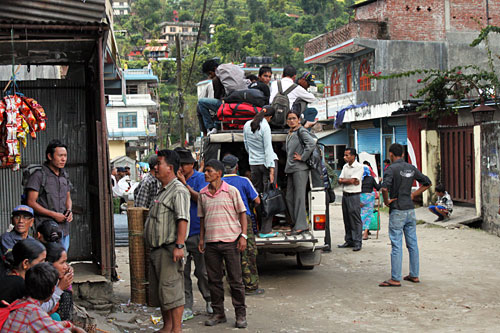
Life in the tiny mountain village is beautiful and simple, but it is not easy. Just getting to the village was exhausting. The previous day I took a bus from Pokhara to the end of the line in Besisahar, where I was met by Prakash, my guide and translator for the duration. My host, Giri Gurung of Nepal Tourism Travels, had explained we would take a 4-wheel drive jeep from Besisahar up to Puma. I foolishly assumed this would be a private jeep and so was surprised when Prakash led me to a street corner where dozens of people were waiting for public transport jeeps.
As the only means of access to these remote communities other than walking, seats were in demand; many people had been waiting since the previous day. Prakash harangued each driver that pulled up, trying in vain to get us seats. Three hours later I was still sitting with my back against the rattling tin wall of a shop with my feet stretched out into the dusty dirt street, having long since given up hope that we would reach Puma that day. Prakash, however, was not so easily discouraged. He continued to beg for a seat, offering to pay more than the 110 Rupee fare ($1.50 U.S.), and finally convinced one jeep owner to kick other passengers off to make room for us when he upped his offer to 250 Rupees.
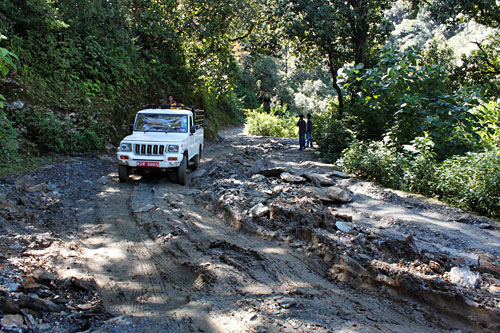
I climbed into the rear and plunked down on one of two facing wooden benches running down the sides of the extended cab, balancing my pack on my lap rather than relegating it to the rooftop and chancing damage to my electronic equipment. A long-legged man sitting across from me roughly shoved my legs apart and thrust one of his knees between mine, while the woman to my left poked her shoulder firmly into my breast. With my hiking boots taking up more than an equitable share of the precious little floor space that was not mounded with sacks of grain and boxes of cooking oil, we started uphill on a rock track gutted with twin trenches that masqueraded as a road.
Within minutes we were high above Besisahar, jouncing through 18” deep ruts and skirting giant boulders. Around a long curve the city disappeared, replaced with vistas of lush gold rice fields ready for harvest and newly-planted fields of grass-green millet, terraced down mountains rising in every direction. Half an hour into the trip, suffering from bruised knees and a sore throat brought on by cold evening temperatures, the jeep ground to a crunching halt, sunk to mid-wheel in ruts made muddy by recent rains. We climbed out while the driver expertly extracted the vehicle and then pretzeled ourselves back inside for more torture. One hour later I almost kissed Prakash when he told the driver to stop, turned to me and announced, “We are here.” Gingerly, I shook my half-asleep leg, handed down my backpack, and eased my aching hip and knee down to the road, wondering why I put myself through these things.
Can’t view the above slide show of the tiny village of Puma, Nepal? Click here.
I scrambled down the pebble-strewn path to Aama’s house, dumped my luggage in the guest house (a spacious room with five beds above the stable) and headed out to get acquainted with the family that would be my hosts during my five-day home stay in Nepal. For the next couple of hours, neighbors and extended family began to dribble into Aama’s compound as they do each night, since she is one of very few villagers who own a TV. But this evening, rather than march upstairs for their favorite program they sat on the porch with me, chattering in a stream of unintelligible Nepali interspersed with an occasional English phrase. Chija, already an incredible beauty at eleven years old, sang Row, Row, Row Your Boat for me to show off the English she is learning in her local government school. My attempt to teach her Itsy, Bitsy Spider, complete with hand signals, was met with gales of laughter when Prakash translated. Chija patiently taught me the Nepali words for touch, welcome, and others, most of which I promptly forgot, except for the really important ones: water is pani and toilet is char pee. They left me finally, drawn by the lure of TV, and I gratefully climbed beneath a thick comforter for a night of delicious, deep sleep in the cold mountain air.
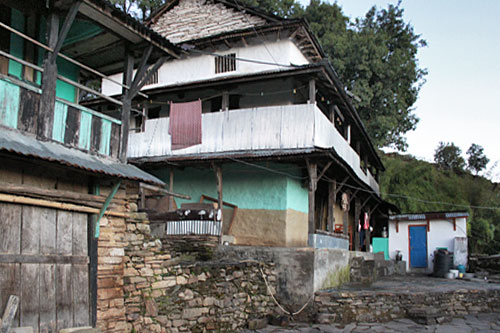
The next morning as I was enjoying my tea and the stunning views, Aama, bent over with age, slowly carried a platter full of gleaming silver urns to the low stone wall at the edge of the patio. Squatting down, she reverently rinsed the vessels, refilled them with water from the artesian well, and sprinkled fresh flower petals on top. Placing the first of these urns on the wall, she faced the sweeping valley and pressed her palms together at her heart, sprinkled water over the wall in a blessing, then repeated her prayers at various spots around the house. Devotions complete, she turned once again to her work, feeding her chickens and scrubbing out the squat toilet.

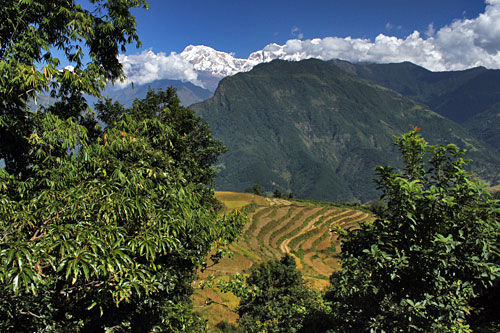
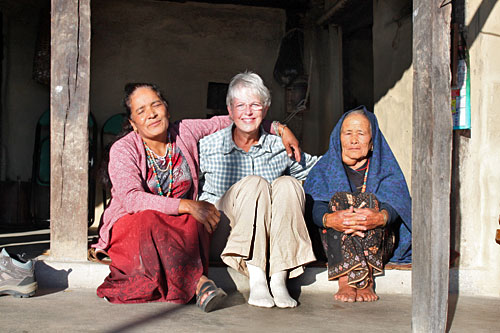
I was embarrassed. I have no chickens to feed or buffalo stalls to muck out. When I am hungry I usually go out to a restaurant or, in the rare instance when I cook, need only turn the dial of a stove. When I am dirty I have hot water at the touch of a knob rather than a metal dipper and a steel tub filled with ice-cold water. I don’t have to grow and harvest my own food or spend a day traveling over obscenely rough roads to purchase basic items. Though incredibly difficult, Aama’s life is filled with music, laughter, love of family, and gratitude. Compared to hers, my life is easy. Yet I cannot find ten minutes each day to meditate and give thanks for all I have, and I no longer had any doubt why my path led me to Puma.
Giri Gurung, managing director of Nepal Tourism Travels & Adventures, organized a portion of my home stay in Nepal, including my trips to Nagarkot, Changu Narayan, Chitwan National Park, and this amazing four-day home stay with his family in Puma. Nepal Tourism Travels & Adventures office is in Kathmandu, conveniently located in the Thamel backpacker district. Their website is www.nepaltourismtravels.com.np, and Giri’s email is [email protected] or [email protected].

That sounds like quite a trip! Great photos of the village and the landscape surrounding it.
http://www.GreenGlobalTravel.com
A genuinely moving experience, with beautiful pictures. It’s fascinating to get such a close-up perspective of the rituals of daily life in Nepal, and I’m really thrilled we’ll be visiting next year… Thanks for writing this, thanks for undergoing the jeep journey, and I hope you do find those ten minutes a day to meditate.
Thank you so much for creating this blog Barbara!
I stayed with Aamaa, Didi and Nani for a month in 2009 and your blog has brought back such wonderful memories of my time there! I taught at the local school so I also know Chija well – such a bright wee button. Wouldn’t stop talking in class though as you can imagine!! I also spent 10 days with Prakash as my guide trekking in Annapurna so it was lovely to see him in the video too!
Having that experience is such a great lesson in understanding just how many gadgets we call ‘necessities’ which really aren’t. While teaching the children at Puma, I had to facilitate a set lesson from their English Social Studies books. There was a picture of a sofa and none of the children knew what it was. And one wee boy asked if an electric beater was a rocket ship! But as you say, even though they have so little compared to what we’re used to, their lives are filled with so much love and laughter.
I can’t wait to go back there one day!
Hi Kimberley! So glad to hear from someone else who has stayed with Aama, in addition to Sherry Ott at ottsworld.com, who originally turned me on to Puma. Seems everyone who visits there come away with this sense of wonder and wishes that we could somehow be more like them. I laughed when I read that Chija wouldn’t stop talking in class; I can just picture it. I also hope to go back someday, in fact, Nepal has so captured my heart that I’m having a hard time thinking about leaving at all. Big hug to you!
I’m amazed that anyone gets up there based on this story, but what a worthwhile experience when they do
Hi Heather: It was quite the ride, but definitely worth the trouble. Such
astounding beauty and wonderful, loving people.
Great story, Barbara. Love reading about Aama, and the picture of her carrying the urns is great. I want to see Annapurna one day. I’m surprised though, I thought being that high, it’s always snow covered…
Hi Dina: The high peaks are perpetually snow covered, and quite beautiful,
when they contrast against the terraced rice and millet fields that flow
down the mountainsides.
Great post Barbara. It brings back memories of walking the Annapurna Circuit 24 years ago. Especially the ladle and cold water…brrrrh!
I can’t wait to go back.
Hi Jason: Only in Nepal do the phrases “ladle and cold water” and “can’t
wait to go back” go together. 🙂 But I definitely know what you mean.
Frankly, I can’t leave.
I actually meant to say that ,again, you wrote a wonderful article. Enjoy your blog so much!
Thank you Fida, for our kind words, and for being such a faithful reader. I
always enjoy your writing a great deal as well.
Gosh, do you really have to make me jealous? Do you?
What a lovely story!
Thank you Sophie – it was a very special experience.
Beautiful story and the last picture is priceless. 🙂
Thanks BeersandBeans!
Certainly hard, but what a wonderful experience you’ve had in Nepal. The beauty of traveling is discovering the genuinity of such hidden gems.
Absolutely Angela. Meeting people and discovering other cultures is what
travel is truly all about.
Barbara, love the last picture of you posing with Aama and Did.
David
Hi David. Me too. I actually look young! Have a wonderful time in Thailand.
The public transport “supply and demand market” you describe reminds of Mozambique. No jeeps there, tough, only 14 people old toyota vans holding 20-25 passengers depending on the size and skill of compression the passengers… a great place to chat and meet new people when everyone’s privacy and space seize to exist! eheh
Aamaa’s life is great and rich because she values things accordingly to the effort she puts into them, as life always should be. A life too easy carries the peril of making one lazy…
Bless he who takes his life into his own hands!
Good travels,
Nuno
Hi Nuno! Mozambique is definitely on my travel radar, along with Ethiopia. Agh, so many places so little time, but your brief description makes me want to go even more.
Aamaa’s life sounds amazing (apart from all the work she has to do). How long did you stay in Nepal
Hi Zablon: I’ve been here two months and will probably stay a third. Having
a hard time tearing myself away from this country. Strange for me. I usually
am ready to leave after two or three weeks and go on to the next place.
It was just over a year ago that Sherry of Ottsworld.com and I did the Annapurna curcuit. Oh what an experience!! And yes, we stayed for a night and part of a couple days at Didi’s in Puma. Your fine pictures and post brought back many memories. Sherry captured them all in her e-book about our trip. The people in Puma were so friendly and really treated us with good. Did you get a chance to taste Didi’s Roxie? Maybe we consumed it all!
Sherry’s DAD
Hi Sherry’s Dad! I have to say that you are my hero! I know you are in your
seventies and I am in awe of the fact that you did the Annapurna Circuit
trek. There is absolutely no way I could have done that with my knee and hip
the way they are now. I am in pain after just one day (6 hours) of trekking.
Like you, I loved Puma and the people and feel I have made lifelong friends.
I don’t think I had Didi’s Roxie, though I had her roti, the thing that
looks like a giant fried pretzel, but it’s made out of rice. There’s a photo
of her picking one up from a platter in the kitchen. See if it’s the same
stuff you’re talking about. I am forever in Sherry’s debt for turning me o n
to Giri, Didi, Aamaa, and Puma in general.
It was just over a year ago that Sherry of Ottsworld.com and I did the Annapurna curcuit. Oh what an experience!! And yes, we stayed for a night and part of a couple days at Didi’s in Puma. Your fine pictures and post brought back many memories. Sherry captured them all in her e-book about our trip. The people in Puma were so friendly and really treated us with good. Did you get a chance to taste Didi’s Roxie? Maybe we consumed it all!
Sherry’s DAD
For that kind of view I would cross mountains! Just beyond gorgeous. And I love love love that last photo. You’re my hero!!! 🙂
Hi Global Butterfly: Then you must pack up and go to Nepal! Just contact the
guide I used (his info is at the bottom of my articles) and he will arrange
it all for you. It is incredibly affordable here in Nepal, once you get
past the airfare.
I’m grinning ear to ear! I can’t tell you how much I love that village and Aama and Didi. It’s so special to me that you went there and I could share it’s magical beauty with others. I sent the post to my dad too as he fell in love with it when we were there a year ago. When I was there – the jeep road was closed and we had to hike up for 3 hrs to get there! It’s changed so much in just 2 years…’running’ water via hoses, toilets…amazing! Barbara – thanks for going and staying there! I can’t wait to go back again!
I’m grinning ear to ear! I can’t tell you how much I love that village and Aama and Didi. It’s so special to me that you went there and I could share it’s magical beauty with others. I sent the post to my dad too as he fell in love with it when we were there a year ago. When I was there – the jeep road was closed and we had to hike up for 3 hrs to get there! It’s changed so much in just 2 years…’running’ water via hoses, toilets…amazing! Barbara – thanks for going and staying there! I can’t wait to go back again!
Hi ottsworld: And I can’t tell you how grateful I am that you helped me make
this trip happen, set me up with your guide, and turned me on to Puma. What
a wonderful, healing place it is.
Great post. I’m jealous!!
Edward – Thanks so much. If you have a chance, hop a plane and visit this
country. It is spectacular!
Barbara, you are having adventures that I can only imagine. The photo of the Annapurnas is beautiful, as is your smiling face in the photo of you sitting with your hosts. Your experiences are what travel is all about.
Thank you Donna. For years people have been asking me what is my favorite
place in the world and I can finally answer them – it’s Nepal, and I guess
that shows in my smile.